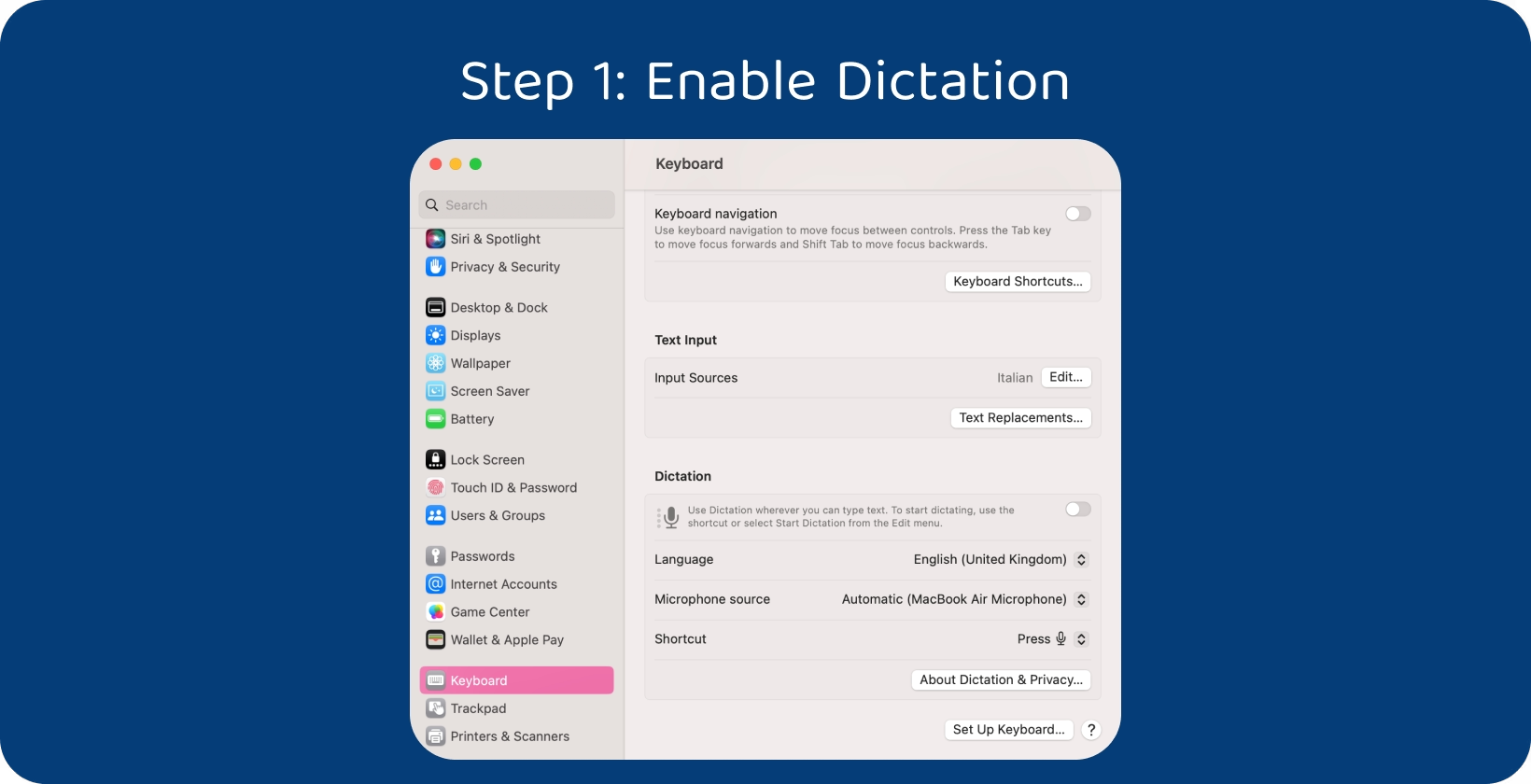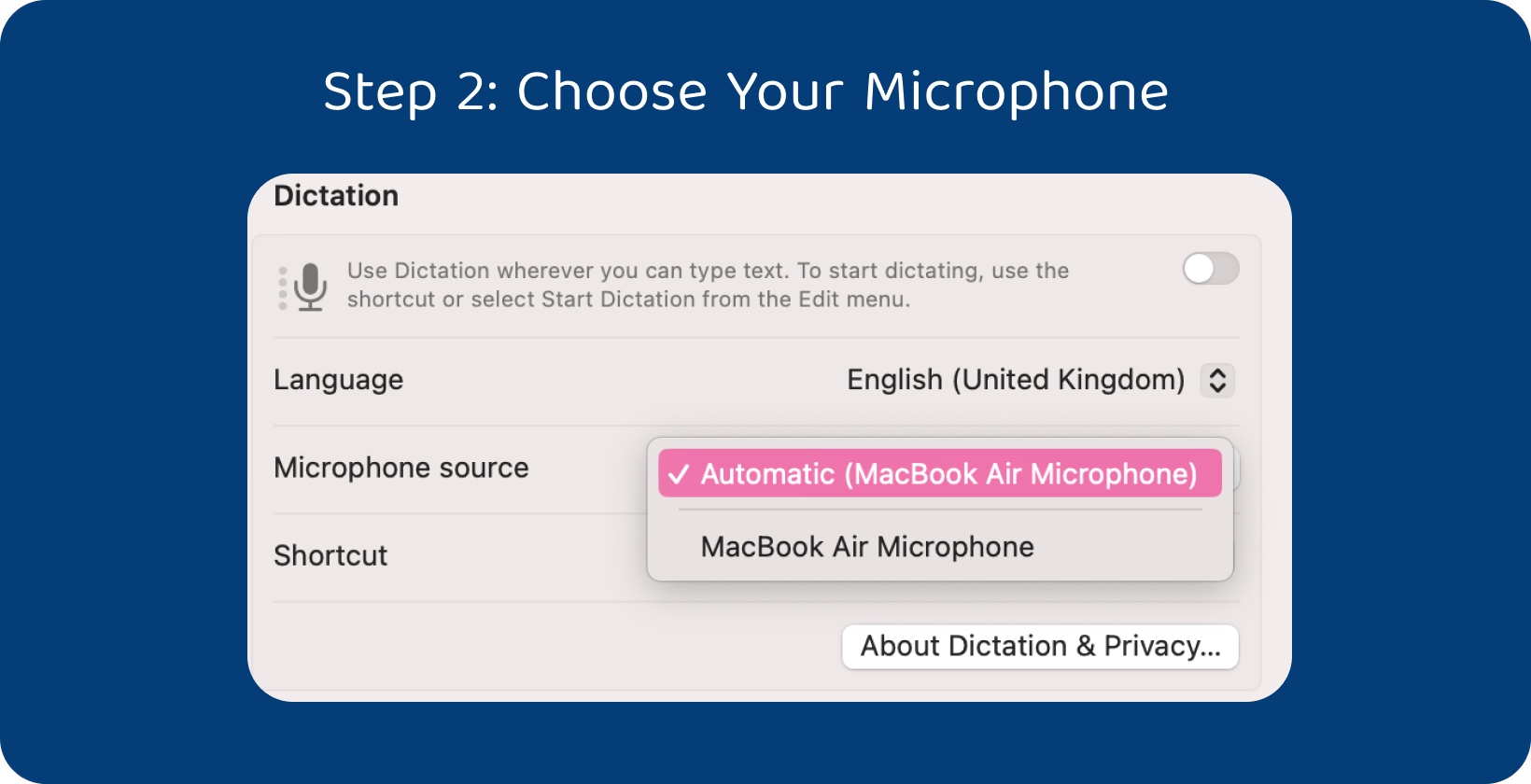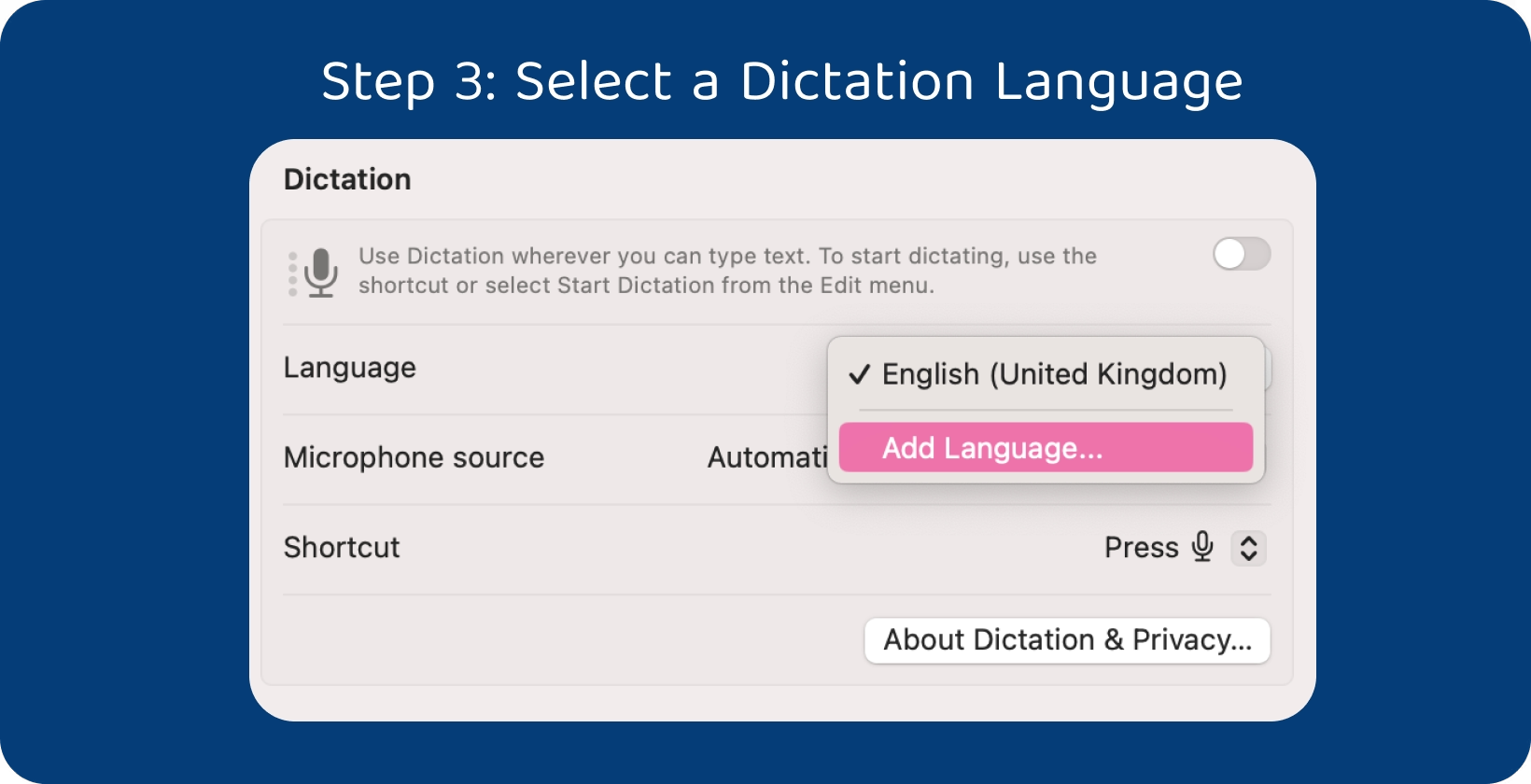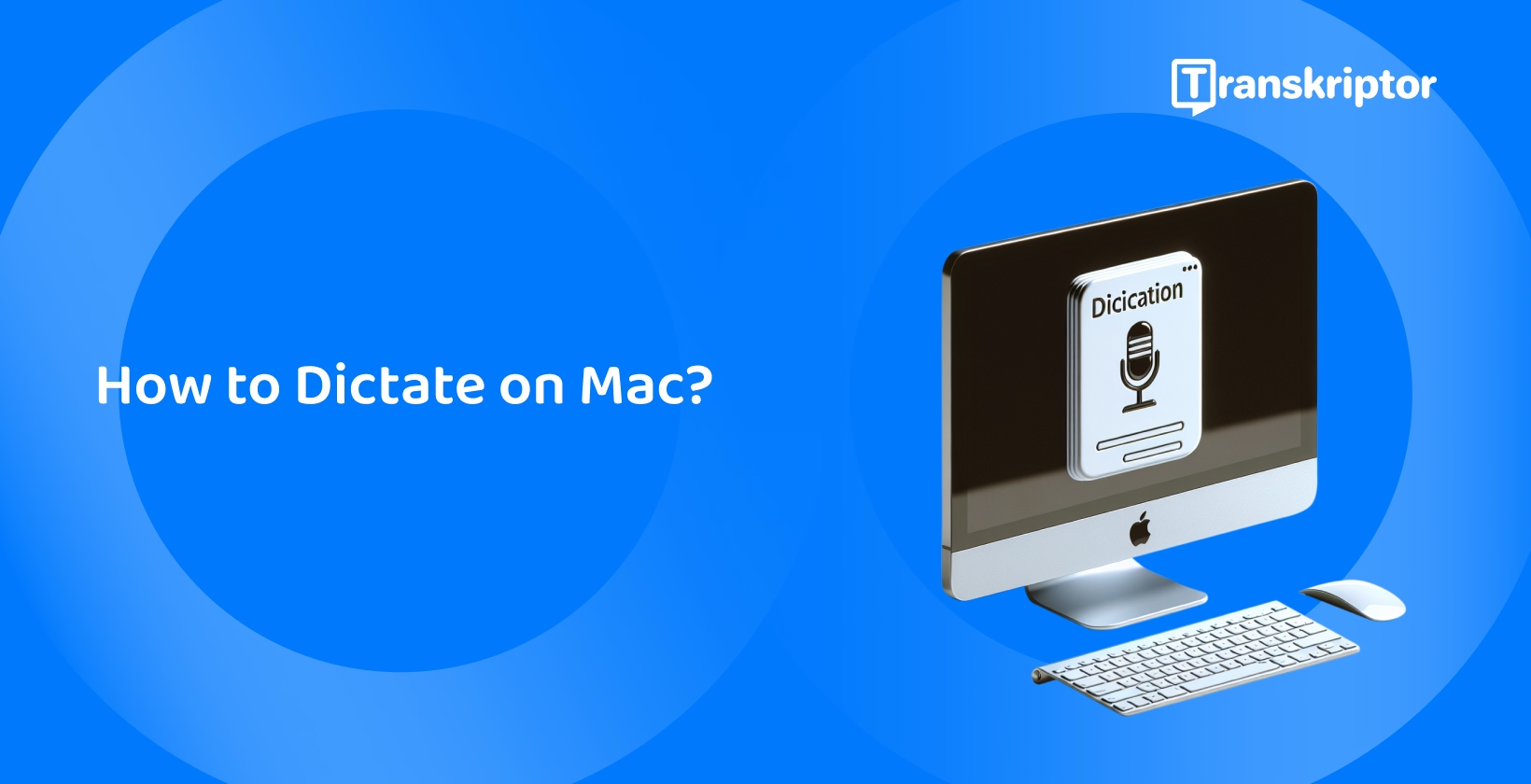Choose the microphone to use for dictation and ensure it is properly connected and positioned for optimal audio input. Select the language to dictate from the available options to ensure accurate transcription . Speak clearly and naturally and avoid speaking too quickly or softly to maintain transcription accuracy.
The 7 steps to dictate on Mac are listed below.
- Enable Dictation: Go to System Preferences, select Keyboard, and choose the Dictation tab to enable dictation.
- Choose Your Microphone: Select the microphone you will use for dictation.
- Select a Dictation Language: Choose the language you will be dictating from the available options.
- Speak Clearly and Naturally: Speak clearly and naturally to ensure accurate transcription.
- Correcting Mistakes: Use voice commands or manual editing to correct the mistakes.
- Learn Advanced Voice Commands: Explore advanced commands to enhance the dictation experience.
- Explore Third-Party Dictation Tools: Consider exploring third-party dictation tools for additional features and customization options.

Step 1: Enable Dictation
Begin by accessing System Preferences, which is found either through the Apple menu or by clicking the System Preferences icon in the Dock. Locate and select the "Keyboard" option. Navigate to the " Dictation " tab situated at the top of the window. Find the settings related to dictation. Simply toggle the Dictation feature by clicking the checkbox next to it. Users might be prompted to download additional language data, if necessary, to support dictation in different languages. Follow on-screen instructions to complete this process.
Customize settings like the shortcut key for activating dictation and whether to use Enhanced Dictation for offline use once Dictation is enabled. Dictation will be ready to use on Mac, empowering users to dictate text using their voice across various applications and tasks with these steps completed.

Step 2: Choose Your Microphone
Return to the Dictation tab within the Keyboard preferences in System Preferences. Find the dropdown menu labeled "Microphone." Click on this dropdown menu to view a list of available microphones connected to your Mac. Select the microphone you want to use for dictation from the dropdown menu. Close the System Preferences window to save your settings. Choosing the appropriate microphone ensures that dictation accurately captures your voice and minimizes background noise for optimal performance.

Step 3: Select a Dictation Language
Remain in the Dictation tab within the Keyboard preferences in System Preferences. Look for the option labeled "Dictation Language" or similar, which allows users to specify the language for dictation. Click on the dropdown menu next to "Dictation Language" to view the list of available languages. Choose the language to dictate from the dropdown menu. This ensures that dictation accurately transcribes the spoken words into text in the chosen language.
Download additional language data if the desired language is not listed. Follow any prompts to download and install the necessary language packs. Selecting the correct dictation language ensures accurate transcription of the spoken words into text.
Step 4: Speak Clearly and Naturally
Begin speaking at a normal pace and volume, avoiding speaking too quickly or too softly, as this affects the accuracy of dictation. Enunciate the words clearly and pronounce them accurately to help the dictation software accurately transcribe the speech.
Speak in complete sentences and avoid using overly complex or technical language, as this is more challenging for the dictation software to transcribe accurately. Pause briefly between sentences to allow the dictation software to process and transcribe the speech accurately. Speak them clearly and explicitly to dictate punctuation or formatting commands. For example, say "period" for a full stop, "comma" for a comma, or "new paragraph" to start a new paragraph.
Minimize background noise and distractions in the environment to ensure the clearest possible audio input for dictation. Maximize the accuracy and effectiveness of dictation on Mac by speaking clearly and naturally and following these guidelines. Effortlessly transcribe the spoken words into text with ease with these guidelines.
Step 5: Correcting Mistakes
Mistakes occasionally occur in the transcribed text Even with clear and careful dictation. Correcting these errors is straightforward. Simply move your cursor to the error, either by clicking with your mouse or using the arrow keys on your keyboard, and make the necessary corrections manually if you notice a mistake in the transcribed text.
Delete incorrect text by pressing the backspace or delete key on the keyboard once the cursor is positioned at the error. Dictate the corrected text or type it manually to replace the error. Ensure that the corrected text is clear and accurately reflects the intended meaning.
Mac's dictation feature offers voice commands for correcting mistakes. For example, say "delete" to remove the last word or phrase, "scratch that" to delete the last sentence, or "undo" to revert the last change. Experiment with these voice commands to find the ones that work best for the workflow.
Step 6: Learn Advanced Voice Commands
It is beneficial to be familiarized with the advanced voice commands for editing and formatting to elevate the dictation experience on Mac. These commands allow users to perform tasks such as editing text, formatting documents, and navigating applications entirely hands-free.
Dictate commands to format text such as “bold,” “italicize,” or “underline” to apply formatting styles to selected text. Use commands like “go to the end of the line” or “scroll down” to navigate through documents. Dictate commands to edit the text such as “delete the last word” or “capitalize the next word” to make precise edits to the text.
Refer to the documentation or help resources provided by Mac’s operating system to learn more about available voice commands and how to use them effectively. Consider experimenting with voice commands in various applications and contexts to discover their full potential. Streamline the dictation experience, boost productivity, and accomplish tasks more efficiently on Mac by mastering advanced voice commands.
Step 7: Explore Third-Party Dictation Tools
Third-party dictation tools enhance the dictation experience and provide tailored solutions for specific use cases. Start by researching different third-party dictation tools available for macOS. Look for features that align with your requirements. Check out reviews and recommendations from other users.
Many third-party dictation tools offer trial periods or demos to test the software before making a purchase. Try different tools to evaluate the functionality and usability of the tools and determine the best for you. Find a solution that enhances the dictation experience and maximizes productivity by exploring third-party dictation tools.
Transkriptor: Best Transcription Tool for Mac Users
Transkriptor stands out as an exceptional transcription tool for Mac users, offering enhanced accuracy and efficiency in transcribing audio recordings. Go to the Transkriptor website and create an account if you do not have one. Record the speech to be transcribed and upload the audio file into Transkriptor.
Ensure to select the appropriate language for transcription before initiating the transcription process. Transkriptor supports a variety of languages, allowing users to transcribe audio content accurately in their preferred language. Initiate the transcription process once the language is selected.
Transkriptor uses advanced speech recognition technology to accurately transcribe the audio content into text. Review the generated transcript within Transkriptor after the transcription is completed. Users edit the transcript directly within the website to correct any inaccuracies and ensure the text reflects the intended content accurately.
Export the transcript from Transkriptor in various formats such as text, PDF, or Word document. Save the transcript locally on Mac and share it with others. Transkriptor offers a reliable solution for Mac users seeking high-quality transcription services, whether transcribing interviews, meetings, lectures, or personal recordings. Try it for free!
Why Use Dictation on a macOS Device?
Utilizing dictation on a macOS device offers numerous benefits, empowering users to convert speech into text seamlessly and enhancing productivity and accessibility in various contexts. Dictation enables users to input text quickly and efficiently without the need to type manually, allowing users to dictate in excel as well.
Dictation provides an accessible alternative for individuals with disabilities or mobility impairments that may hinder traditional typing, such as dictation apps . Dictation enhances accessibility and inclusivity by offering a hands-free method of text input, allowing users to dictate with Apple Watch . Dictation on macOS allows users to convert their speech into text virtually anywhere they type, whether it is in a word processor, email client, messaging app, or web browser. This flexibility enables users to dictate text in various situations, such as when multitasking, on the go, or in environments where typing is impractical.
Dictation facilitates effortless communication by enabling users to dictate messages or responses verbally instead of typing them out manually. Dictation on macOS offers improved accuracy in transcribing spoken words into text with advancements in speech recognition technology. MacOS accurately interprets and transcribes speech, minimizing errors and enhancing the overall quality of dictation.
What are the Advanced Mac Dictation Features?
Advanced Mac dictation offers a range of powerful features that allow users to control their Mac devices with voice commands for formatting, navigation, and text manipulation. Users apply formatting to their text using voice commands. This includes commands to make text bold, italicize, underline, or change font styles and sizes. Users dictate formatting commands seamlessly, enhancing the appearance and readability of their text without needing to use manual input methods.
Advanced dictation on Mac enables users to navigate through documents, web pages, and applications using voice commands. Users dictate commands to move the cursor to specific locations, scroll through content, or jump to the beginning or end of a document. This feature allows for efficient navigation and multitasking without the need for manual input.
Advanced dictation on Mac includes a variety of editing commands that allow users to manipulate text with voice commands. Users dictate commands to select text, copy and paste content, undo or redo changes, and more. These editing commands enhance productivity and streamline the text editing process for users.
Mac dictation extends beyond text input and editing to include voice commands for controlling applications and system functions. Users dictate commands to open or close applications, switch between windows or tabs, adjust settings, and perform various other tasks without needing to use manual input methods.
Benefits of MacOS Speech Recognition
The benefits of macOS speech recognition are listed below.
- Increased Productivity: MacOS speech recognition technology enables users to input text quickly and efficiently through speech, leading to increased productivity.
- Accessibility: Speech recognition on MacOS enhances accessibility for individuals with disabilities or mobility impairments.
- Multitasking Capability: Users perform tasks hands-free, allowing for seamless multitasking with macOS speech recognition.
- Enhanced Accuracy: MacOS speech recognition technology has advanced significantly in accuracy and reliability.
- Language Support: MacOS speech recognition offers support for a wide range of languages, allowing users to dictate text in their preferred language with ease.
Increased Productivity
MacOS speech recognition offers a significant advantage in terms of productivity by enabling faster text input compared to typing. Users dictate text using their voice instead of manually typing, allowing them to complete writing tasks more efficiently. This hands-free approach to text input eliminates the need to type each individual character, saving time and reducing the risk of repetitive strain injuries associated with typing for extended periods.
Accessibility
MacOS speech recognition serves as an essential tool for users with disabilities or individuals who find typing challenging, thereby making computing more accessible. Typing on a keyboard can be challenging or even impossible for individuals with mobility impairments, dexterity issues, or conditions such as arthritis. In such cases, speech recognition offers an alternative method of text input, allowing users to interact with their Mac devices effectively using only their voice.
Multitasking Capability
MacOS speech recognition enhances users' multitasking abilities by enabling them to dictate documents or messages while their hands are occupied with other tasks. Speech recognition allows users to input text using their voice, freeing up their hands for other tasks unlike traditional typing, which requires manual input and limits users' ability to perform other activities simultaneously.
Enhanced Accuracy
MacOS speech recognition continuously improves in accuracy, offering high precision in converting voice to text and reducing the need for corrections. MacOS speech recognition systems accurately transcribe spoken words into text with remarkable accuracy. This high level of accuracy minimizes errors in transcription, ensuring that the resulting text closely reflects the intended spoken words.
Language Support
MacOS speech recognition offers support for multiple languages and dialects, making it versatile for users worldwide to interact with their Mac devices in their native language. This comprehensive language support ensures that users from diverse linguistic backgrounds utilize speech recognition to communicate, dictate text, and control their devices effectively. MacOS speech recognition adapts to different regional accents and dialects, ensuring that users dictate text and control their devices with accuracy and precision regardless of their linguistic variations.
What are the Best Practices for Using Voice Commands on Mac?
Ensure to speak clearly and enunciate the words in a quiet environment to enhance the accuracy of voice recognition. Familiarize yourself with basic voice commands for navigation, dictation, and system control. This includes commands for opening applications, navigating menus, dictating text, and executing system functions.
Practice pronouncing words accurately to improve recognition accuracy, especially for complex or less common terms. Keep commands concise and straightforward to minimize recognition errors. Shorter commands are easier for the system to process accurately. Provide context or punctuation commands such as "new paragraph" or "period" to ensure accurate transcription and formatting.
Utilize natural language when dictating text or issuing commands. This makes interactions with your Mac feel more conversational and intuitive. Review transcriptions for accuracy and make any necessary corrections manually after dictating text. This helps refine the system's understanding of the voice and improves future recognition accuracy.
Maximizing Accuracy with Transkriptor: The Role in Mac Dictation
Transkriptor plays a pivotal role in maximizing accuracy and efficiency in Mac dictation. Transkriptor leverages advanced speech recognition technology to ensure precise and reliable transcription of audio content into the text as a premier transcription tool. Transkriptor's cutting-edge features and intuitive interface empower users to achieve unparalleled accuracy in transcription.
Transkriptor streamlines the transcription process and delivers highly accurate results whether you are dictating emails, transcribing interviews, or drafting documents. Transkriptor streamlines the transcription process and delivers highly accurate results. Transkriptor effectively recognizes diverse accents, dialects, and speech patterns, ensuring accurate transcription regardless of linguistic variations with its robust language support and adaptive algorithms.
Transkriptor offers customizable settings and editing capabilities that enable users to refine and polish transcribed text with ease. Transkriptor provides the tools necessary to fine-tune transcriptions to perfection whether it is correcting errors, formatting text, or adding punctuation. Try it for free!

